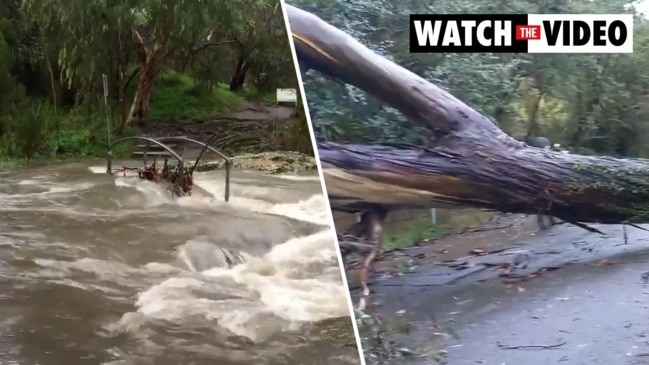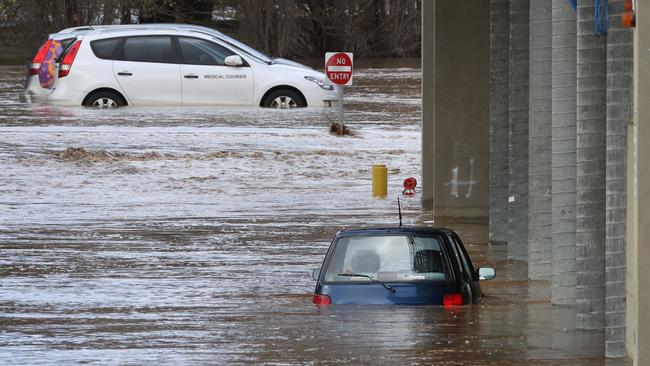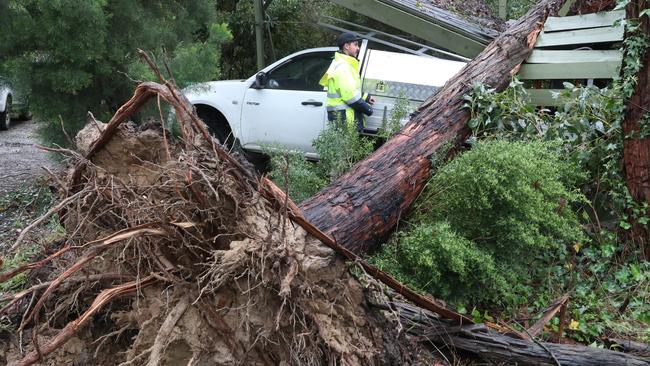Victoria floods: man dead, ‘absolute carnage’ hits state
A man is dead and hundreds of residents were forced to flee their homes after flash flooding and destructive winds belted Victoria.

A man is dead and hundreds of residents were forced to flee their homes after flash flooding and destructive winds belted Victoria.
The man in his 60s was found in a car “almost submerged” in floodwaters on Starling Lane, Woodside, in the state’s far east, about 2pm on Thursday.
“A rescue team has recovered the deceased man and the circumstances surrounding his death are being investigated,” Victoria police said in a statement.
Conditions have slowly eased & the severe #weather warning for damaging #winds is now cancelled. #Rain has eased too, but multiple #flood warnings remain current at https://t.co/CX7QbIHXfa
— Bureau of Meteorology, Victoria (@BOM_Vic) June 10, 2021
📷 @maddie__spencer - Traralgon, Kelly Van Ben Berg - Budgeree, Ben Rothberg - Lilydale pic.twitter.com/VbOKi8mgG9
It came after damaging winds left a house split in two in Olinda — about an hour east of Melbourne — after a tree crashed onto it.
Victoria’s emergency management commissioner Andrew Crisp said the wild weather hit huge swathes of the state from Lorne on the Great Ocean Road, to metropolitan Melbourne, to the Macedon Ranges in the north and Gippsland in the far east.
Victoria’s SES responded to more than 6500 calls for help by 4pm on Thursday, with the majority — 5213 — related to fallen trees. More than 800 requests for assistance related to building damage.
Flooding in the Traralgon creek and township — about two hours east of Melbourne and in the Latrobe City council area — forced authorities to order 200 people to evacuate their homes after the Strzelecki Ranges copped more than 200mm of rain on Wednesday night.
Despite the order, Traralgon resident of 33 years Stephen Ruff said he would “wait it out” at his home on Berry Street, located 100m from the overfull creek.

“The creek is in our backyard and front yard and everywhere,” the 71-year-old said.
“We were lucky, the water got to within an inch and a half of coming in our door. The cars have got water in them (so) we will sit it out,” he said.
“The poor people over the road … had their clothes drier float down the road. They have lost everything.”
Latrobe City mayor Sharon Gibson said although a relief centre had been set up at the Traralgon basketball stadium, the state’s Covid-19 restrictions would not allow them to let people sleep there if they could not return to their homes.
“Normally in a relief centre you would have people staying but (we) can’t do that,” she said.
“We have road closures, evacuations happening, power cuts — what else can we throw in the mix? Oh, hang on, we have Covid restrictions.”

At noon on Thursday more than 200,000 people were without power. Lilydale — an outer eastern suburb where more than three key power lines were out — was expected to be without electricity for days.
Bureau of Meteorology senior meteorologist Kevin Parkyn said a low pressure system off the Tasman Sea caused the widespread storms.
“It wasn’t just about the rain, many people would have woken up this morning and seen absolute carnage out there — broken branches, tree snapped out of their roots,” Mr Parkyn said.
“Some of the hardest hit areas were the Central Highlands (which cover land from Melbourne’s west near Geelong to the Grampians), the Dandenong Ranges, down on the peninsula, around Melbourne but also west and south Gippsland,” he said.
“They have been really hard hit and not only with intense rain and flash flooding, the major flooding in their river systems, but they had to contend with these destructive southerly winds as well.”

Between 50mm and 100mm of rain fell in the central ranges overnight on Wednesday and west and south Gippsland copped up to 150mm.
Rain that fell on Mount Baw Baw — 150km west of Melbourne — broke records after it received a deluge of 278mm. A flood warning was also issued in the Upper Yarra region after 241mm fell.
Winds of up to 115 km/H were recorded at Wilsons Promontory in the state’s far southeast.
Before the man in his 60s died on Thursday, Victoria SES operations chief Tim Wiebusch said at least a dozen people had to be rescued after they attempted to drive through floodwaters and urged people not to do it.
“We can’t emphasise enough that driving into floodwaters is the greatest risk that you can take, we know that from the statistics that is the number one thing where we see fatalities during flooding.”





To join the conversation, please log in. Don't have an account? Register
Join the conversation, you are commenting as Logout